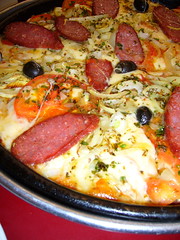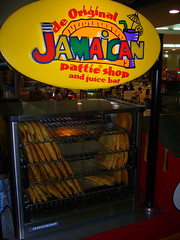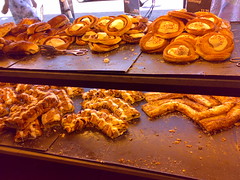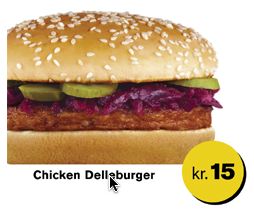Why globalization won't make everything the same
Published September 18th, 2007 edit replace rm!
I had an great discussion the other day with a family member who argued that one of the problems with globalization was that in the end everything will be the same no matter where you go – the same food and the same music. Obviously if this were to be the case it would suck. I mean that would take all the fun out of travelling and rid everyone of their own culture and heritage etc. So I’m sorry I’ve got yet another long rant coming.
However if we take the examples of food and music (both things I love dearly) I doubt very much that this is what we will see. Undoubtedly we will see greater changes coming around quicker than before, however the world has had several period of rapid globalization before. Just think of the Spanish conquest of the Americas, the Ottoman empire, the British empire etc. On the right hand we have a product of large scale Danish emigration to Argentina about 100 years ago.
I think the real danger is when you sit in one place of the world and view the changes to the world you are rally by definition viewing them from your point of view. For example if I’m sitting in California, I might see the world is changing with pure American brands and media taking over the world. What is more difficult to see is the way each culture adapts, absorbs and changes each new import to create a new micro fusion, whether it be music, food, web sites or TV. The same is happening all over the world as it always has happened in the past.
The problem with this fixed point of view is that while I might see influence of Chinese, Mexican, Indian or Italian food in my neighborhood, I might not realize that what I’m seeing here is NOT pure Chinese, Mexican, Indian or Italian food, but rather Chinese/Californian, Mexican/Californian, Indian/Californian and Italian/Californian micro fusions. The same is true in every single other country and locality in the world.
A pizza is not just a pizza
2 obvious micro fusions for Americans are the various regional pizza types that exist within the US. New York Pizza’s are large thin crust and juicy, Chicago Pizza’s are thick and very different. However these evolved I have no idea, maybe immigrants came from different parts of Italy, maybe availability of ingredients and ovens where different between Chicago and NYC 100 years ago. It could also be that some one in Chicago was a bit creative one day and it took off. However what you see are big differences in italian food just within the US borders.
What about Italian food outside the US?

Argentina had nearly as many Italian immigrants as the US. What did they make of the Pizza? On the right you’ve got a Buenos Aires Deep Pan Pizza, but they also do thin crust, white pizzas and they are all very different than US or Italian pizzas.
While the first Pizzarias in Denmark where run by Italian immigrants, nearly all of them today are run by Middle Eastern immigrants, which has created strange little micro fusions of Italian, Middle Eastern and Danish food. One of the most popular pizza toppings is Shawarma meat and another curios fusion called the Pizza sandwich has evolved, which is basically a pita the size of a Calzone and freshly baked stuffed with fresh ingredients be it Pepperoni or Shawarma or Ham.
Any way all of these micro fusions are what makes Pizza blogs like Slice fantastic reads.
But hang on a minute. Aren’t many Italian classics also products of early globalization? Pasta came from China, tomatoes from the Americas. Are the Italians eating Chinese food when they cook up spaghetti bolognese?
Is Jamaican culture taking over the world?
I used the example of Italian food before, as everyone knows about Italian food. What about cultures that we might not be so familiar with. What do you know about Jamaican Culture? Jamaica is a small country with a couple of million inhabitants, yet these cultural imperialists are taking over the world.
The imperialist Jamaican flag hanging outside a Nigerian restaurant in Tallinn, Estonia:
Very few people nowadays haven’t heard of Bob Marley. I have seen wannabe Rastas in just about every country I’ve ever visited from Europe to Argentina to the Philippines.
But Jamaican music has evolved a lot since and was even influential before Bob Marley. Ska which was the most popular sound of Jamaica in the 60s has now transmogrified into Ska Punk in the US and Argentina – completely different yet still Ska.
Jamaican Dancehall became Reggae en Español when Panamanian’s of Jamaican descent like Renato, Nando Boom and El General started doing Spanish covers of Jamaican greats like Gregory Isaacs and Barrington Levy. They then started creating their own style which took Latin America by storm about 10-15 years ago (evil Panamanian imperialists).
Now Puerto Rican DJ’s took Panamanian Reggae and mixed it with a bit of American Hip Hop and a sprinkling of Dominican Bachata to create Reggaeton, which has now led Daddy Yankey’s Gasolina to be one of the single most annoying yet recognized songs where ever you go in the world. Bastard Puerto Rican imperialists first they brought us Salsa, then Living la Vida Loca and now Gasolina. Even Jamaican dancehall tunes of the last couple of years having been spared the reggaeton influence with occassional shout outs of “Culo” and plonk of a Bachata guitar to be found.
Not even Denmark is spared Jamaican imperialism. Through the regular sunday reggae night Rub ’A Dub at Stengade 30 in Copenhagen a bunch of great acts like Bikstok Røgsystem have created really cool Danish/Jamaican microfusions.
But wait Jamaican imperialism doesn’t stop with music. You can now find watered down “Jamaican Jerk” chicken on the menus all over the world, but what really interests me is street food like Jamaican Patties – basically spicy beef turnovers. Jamaican Patties might be unknown to you if you live outside New York City, Toronto, Miami, Jamaica or Manila?? I discovered several Jamaican Patty chains in Manila:
De Original Jamaican Pattie Shop was started twelve years ago as a direct result of collaboration between members of the prominent Ablan family of the Philippines and the equally prominent Chang/ChinYee family from Jamaica.At that time most Filipinos had no idea what a Jamaican Patty was but with determination and belief in the product De Original Jamaican Pattie Shop gradually popularised authentic annd original Jamaican Patties, using recipes and techniques from the best Pattie makers in Jamaica. Jamaican Patties in the Philippines
Or what about this chain in Panama:
Again evil Jamaican imperialists. Need I say more? Well I will.
Salsa, Cuba, Puerto Rico etc.
You might have noticed that I mentioned above that Salsa is from Puerto Rico. Well it’s not. Many people think it’s Cuban and they wouldn’t be entirely correct either. It actually developed in New York in the sixties and 70s as a truly Pan latin fusion of Cuban, Puerto Rican, Dominican, Panamanian and Colombian traditional music. The largest stars came from all over the Latin Caribbean region and New York – Willie Colon (NYC), Hector Lavoe (PR), Celia Cruz (Cuba), Ruben Blades (Panama), Joey Arroyo (Colombia) and many others were all important pieces in the development of this truly American fusion.
Again we see Havana Clubs, Bar Salsa and any number of variations of that in every single major city in the world. Tokyo and Helsinki are supposedly hot beds of Salsa activity. Evil Cuban Puerto Rican Dominican Panamanian Colombian American imperialists forcing salsa onto the world. Of course the original laid back informal dance of salsa has now become rigidized and formalized in a manner that fits better into Scandinavian and Japanese cultures, the exact same way competitive latin ball room dancing has little in common with their original Cuban inspirations of the 50s.
How evil Austrians scabs took our jobs and invented the Danish pastry
According to the Danish pastry check association (in Danish) the origin of Danish pastry’s came during a bakers strike in Denmark in 1850. As Danes couldn’t possibly survive without bread or cakes a flood of Austrian bakers came in to work the bakeries. They brought with them their Austrian pastry, which was also the source of the “French” croissant and started creating Pastry’s. They became a hit in Denmark and when the Danish bakers decided to go back to work they started making them as well. I’m sure Denmark has variations that aren’t in Austria, but the basic invention was Austrian.
So how come people around the world aren’t eating Austrian’s for breakfast? According to WikiPedia it was the work of a single Dane L. C. Klitteng who founded the Danish Culinary Institute in New York and tirelessly promoted it. Evil Danish Austrian Danish imperialists.
Of course the Danish pastry’s found in the US are nothing like what I would get from my local baker in Copenhagen. Of course neither is a Danés con Guayaba in Panamá or one with purple yam in Manila. They are all successful microfusions.
McDonalds forcing American food on the world
McDonalds are surely the poster child of evil imperialists forcing us all to eat the same food. Such as the traditional American DelleBurger in Denmark:
And the old American classic McRice Burger in Manila:
Of course these aren’t American but microfusions albeit commercial between the traditional Danish frikadelle (meatball) and the US hamburger as well as the rice burger, which I gather is a Japanese/American micro fusion.
Finally he reaches his point
My point of all this is that excercise in music and fast food is that yes you can buy American fast food just about everywhere nowadays but it’s often as American as a Chicago pie is Italian. This isn’t the first globalization movement that has changed tastes of the world and it won’t be the last, but this globalization doesn’t create a safe bland boring world as many people like to say.
My other point is that many of the local favorites around the world where results of chains of micro fusions. Whether we are talking about the Danish pastry in a coffee shop in Seattle, a lasagna in Bologna, Chicken Tikka Massala in the UK, Tandori in India or balut (please do not click that link) in the Philippines. These were all the result of one or more invasions, discoveries, immigrations or trading missions throughout history.
We also thankfully do get a backlash many places with both England, Denmark and the US for example seeing trends in “traditional foods”. Of course many of these traditional foods are often not entirely native either.
Every Italian and Lebanese restaurant in Panama serves traditional Ceviche and KFC servers Sancocho and Arroz con Pollo. All foods very important in the Panamanian national psyche, but of course all distant derivatives of dishes brought over from Spain some 400 years ago.
Many of the traditional Danish foods have French influences from around the turn of the century. Fish & Chips is apparently a Spanish import to Britain. Tandori in India came with the Persian conquerors 400 years ago and Chicken Tikka Massala took was invented in the UK by Indian chef’s using said “Indian” Tandori chicken as the base for a new dish unknown in India. Filipino Balut was actually a Chinese invention.
And yes there will be some things that are boring. Like I’m sure you can now find tuna tartar on menus in every single country, go figure. But hey you don’t have to actually order the tuna tartar when you can order a Shawarma Pizza instead.
So globalization will create some definite similarities, but it will not erase the differences and it will no doubt create whole new levels of differences that probably will create whole new classics in the future.
Music fads change quickly, probably about as quickly as internet fads. Food and clothes a bit more slowly, yet still fast enough that we can see large changes over a 10 year period. I’m here for the ride and I’m sure it’ll be fun and not at all boring.







Michael September 24th, 2007
Great post, Pelle – spot on!
I was trying balut for the first time yesterday. Definitely an experience.
Chuck October 19th, 2008
You conveniently gloss over the fact that Globalization means the death, suffering, and destruction of thousands of cultures and populations. There will always be resistance to power when it meets change and the more people and nations instigate, the stronger the backlash will be. Future generations always remember the evil done to their ancestors.
Central Africa
http://www.youtube.com/watch?v=JhsGToL60pg
Religion And Globalization In Puerto Rico
http://www.youtube.com/watch?v=rEd5abRSDXU